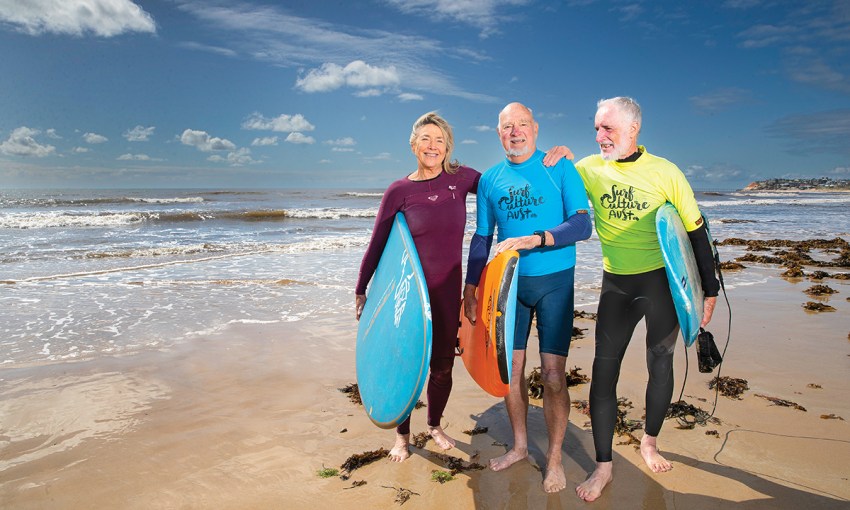Three South Australian surfing pioneers, now aged in their 70s, tell SALIFE about the early days of surf culture here and why, all these decades later, they remain just as passionate about chasing the perfect wave.
Sands of time
Surfing in the 1950s and ’60s was a burgeoning new trend on Australian beaches. Novice surfers learnt on cumbersome boards, watched on by bikini-clad girlfriends, while The Beach Boys provided the summertime soundtrack. For many of those young enthusiasts, surfing epitomised a new way of life, a freedom and feeling that anything was possible.
Ray Palmer, 70, Seaford
As kids in the 1950s, Ray Palmer and his younger brother Garry would spend all summer at Glenelg Beach. Their father, Sydney, would pack the family’s HR Holden and head from their home in Camden Park for a day of sun, surf and sand.
The boys were about 10 years old when Sydney introduced them to the new craze of surfing and from the get-go, they were hooked.
“I still remember the first time I stood up on a little six-inch wave, it was such a buzz and I was going, ‘I’m standing, I’m standing’,” Ray says.
“We started off with a wooden hollow surfboard, where every time you came in you had to pull the plug and pour the water out of it. We loved it.”
Ray got his first car, a Ford Anglia, at age 16 and he and Garry then followed the waves wherever they were breaking including the mid and south coast and Yorke Peninsula. They’d often surf all day and sleep on the beach at night around the camp fire.
“It all progressed to the hippy era, we all had long hair … we had regular jobs, but got away on surf trips at every opportunity. Yorkes and the West Coast around Streaky Bay and Cactus were our favourites. Both Garry and I spent time living in the desert at Cactus for extended periods, surfing the perfect wave and getting in tune with nature.”
They used boards made by local manufacturers including Don Burford Surfboards, Wayne Dale, who shaped boards for John Arnold Surfboards, and Rodney Bedford from Jay Bee Boats and Surfboards.
“We’d go for the local product, a local board for local waves,” Ray says. “We went to the nine-foot Malibu boards once I turned 16 and got my own car, and the real short-board era came in the late 1960s. That progressed to the single-fin short-boards in the 1970s and then the triple-fin boards. Thrusters, came in the late ‘70s early ‘80s. So, we’ve been through the whole evolution of surfing.”
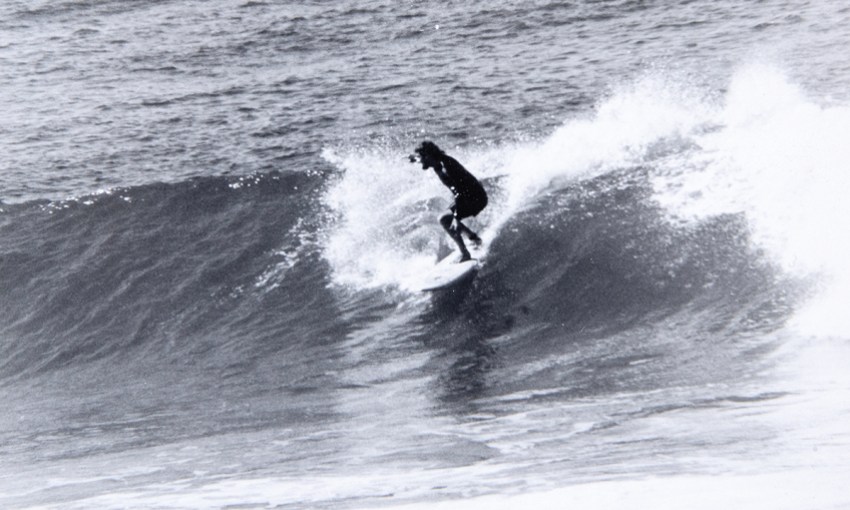
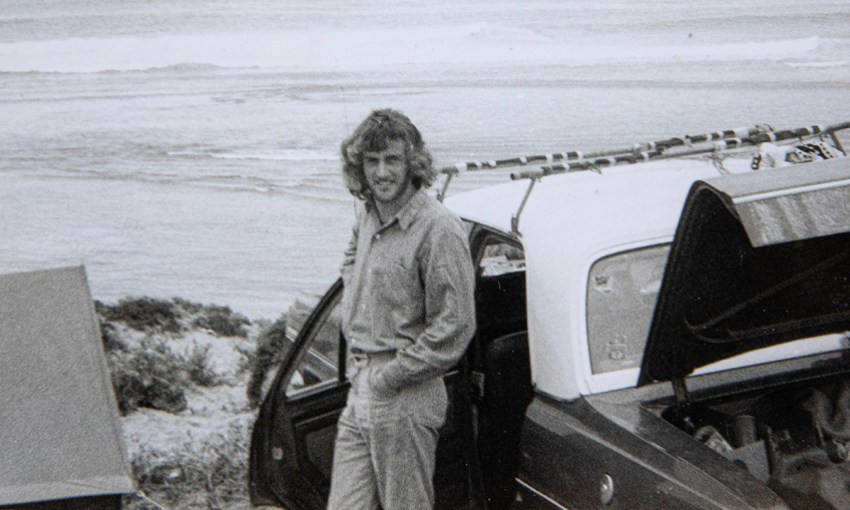
Ray, who worked as a hairdresser and also taught hairdressing at TAFE, continued to surf all his life.
Today he and wife Susan live at Port Noarlunga South, close to the surf, and Ray gets out as often as he can.
While Susan isn’t one for the waves, Ray taught their daughter Erin, now 38, to surf as soon as she could hold a board.
“When she was a teenager that’s all she wanted to do,” Ray says. “We’d go on camping trips to Yorke Peninsula and surf with dolphins. Some of my most memorable moments were days surfing at Berry Bay near Corny Point, there’s always dolphins out there. Now I’m taking my grandkids Lily and Caleb down to the beach and they are stoked as well.”
Ray has also taught surfing to kids since 1991, initially helping out a mate who ran surf schools in Middleton and Moana.
These days, he teaches surfing with Surf Culture Australia as part of an outdoor education curriculum with private colleges. He is booked solid over summer and says teaching kids to surf for the first time gives him that same buzz he got as a youngster on the board.
“I get that same reaction from the kids that I had as a kid, yelling out, ‘I’m standing, I’m standing’, it’s great,” Ray says.
In 1995, Ray also helped establish the Classic Lines surfing club which was originally called “8 Footers” because all the members liked eight-foot Malibus.
“We then changed the name to Classic Lines when light-weight, nine-foot competition longboards were the go. Before that many of us were part of another club called ‘Maladjusted Longboarders’, which was started in the 1980s.
“With two clubs we were able to run spirited inter-club comps.”
Today, Classic Lines caters for ages from 16 to 70-plus, with about 60 per cent of members older than 50. There are currently about 30 members and competitions are held once a month and at the end of the year when they announce the club champion.
“I like the social side of the club, mixing with like-minded surf loving people,” Ray says. “We are pretty laid back but still like to kick each other’s butts in our competitions.”
Ray has been a club champion as well as a state and national title holder. He won a national title on a short board in North Stradbroke Island in the over 50 division in 2003.
“I now compete in the state titles short board in the over 60 division and in the long board state titles over 70 division,” he says.
“I love it, it’s mentally good for you, just the mindfulness, gets you away from thinking about everyday things, as well as keeping you fit.”
So how does he feel when he’s standing on that magic wave and slicing through the water?
“The feeling of using the natural energy of the ocean to draw lines as you race towards the shore is hard to describe,” he says. “The ultimate being when you get completely covered up in the barrel, it’s the same feeling people get after winning a premiership.
“I’m 70 now and still surfing and coaching. When I was younger, I thought once you get over 30 you’ve had it. I remember one of my mates Andy Inkster won a surfing comp years ago and 5KA interviewed him and asked, ‘How long do you think you’ll be surfing?’ and he said, ‘I’ll stop when they put me in a box’. So, that’s my motto, too, these days.
“I’ll just keep going because as long as you can keep doing it, you can keep doing it.”
Sue Bennett, 70, Seaford
At 70 years of age, Sue Bennett is the embodiment of ageing well and the former teacher equates healthy longevity to her lifelong love of surfing.
“I used to say I’m going to surf until I’m 80, now I’m saying 90,” laughs Sue, who began surfing in the 1950s.
Sue, and her brothers Ian and Kim used a flat wooden board built by their father Alfred.
“There’s a photo of me when I was about two years old holding this board, the ‘ironing board’ we called it,” Sue says. “It’s just a plank of wood that Mum actually used as an ironing board.
“She used to cover it with a blanket and sheet and do the ironing. It even had a burn mark on it where Mum accidentally burnt the iron through. I’ve still got that board.”
Sue recalls laying on the board as she rode the waves, developing her confidence before standing up. The family lived in Urrbrae but spent summer holidays at Moana or Christies Beach and then Goolwa where they built a beach house.
By the age of 10 Sue had advanced to a blow-up surf mat with fins, while her brothers used nine-foot Keyo boards.
However, by the time Sue was a teenager, she was determined to master a surfboard, even though it was largely frowned upon for women to surf.
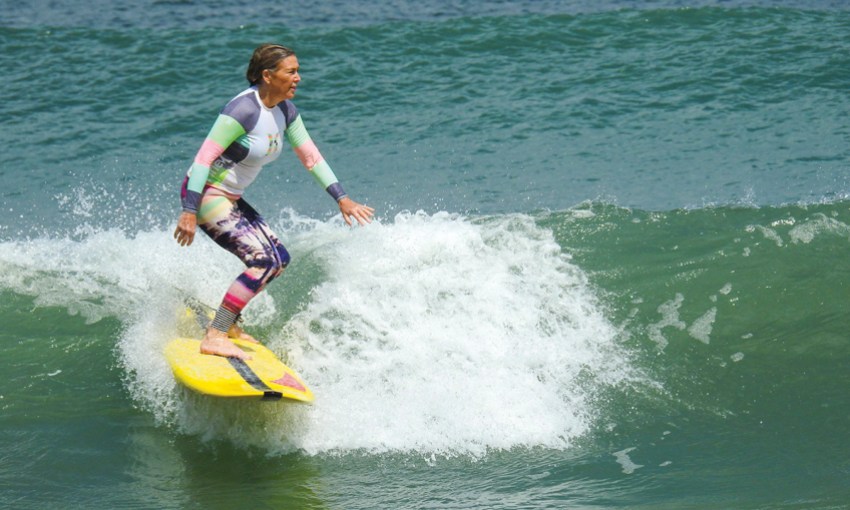
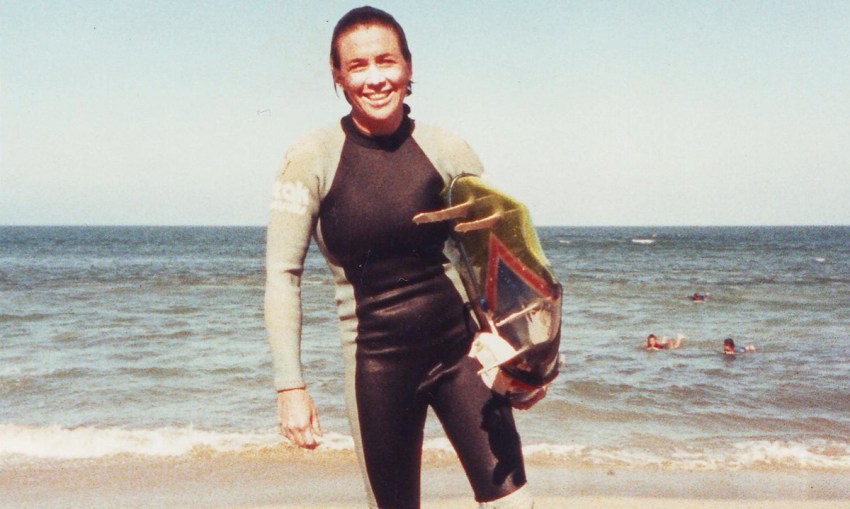
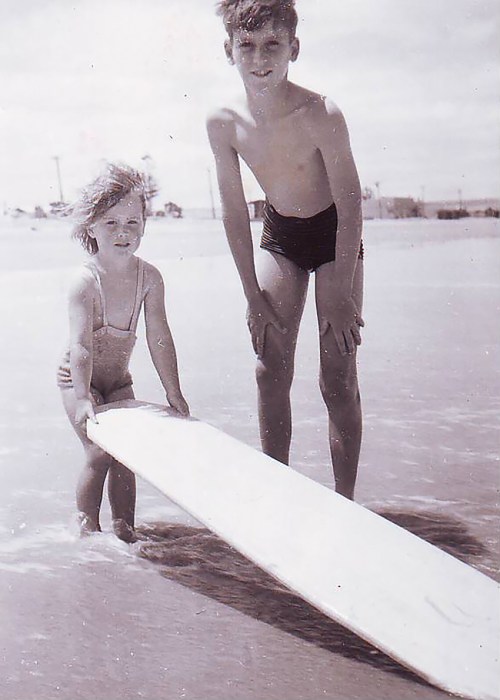
Sue clearly recalls the day she secretly took her boyfriend’s surfboard out into the water. He and his friends had fallen asleep on the beach, so Sue pinched his board and hit the waves.
“I had no idea about how to use one of those boards, I don’t think I even got to my feet, but I was keen to learn,” she says.
“That sort of thing went on a lot. I went to Cactus in about 1974 and I took my surf mat and when my boyfriend saw it in the boot he was horrified. He said, ‘don’t you let anyone see that’.
“It was like the movie Puberty Blues where you had to watch them surf and tell them how good they were.”
Sue ran into that ex-boyfriend in recent years and he apologised for his behaviour, and they enjoyed a surf together.
A teacher by profession, Sue managed to incorporate surfing into her working life and while she was teaching at Para Hills High School in the 1970s, a colleague set up a surfboard-making elective. Sue joined in, keen to make her own board and expand her knowledge.
“I had an old car, a Cortina, with those awful old metal roof racks and I’d put the board on the roof and head to the beach with a girlfriend,” Sue says.
Gradually over the years, Sue began to meet other women who liked to surf and by the 1980s they joined an organisation called Women’s Surfing Association.
“It was formed by the earliest pioneers such as Nola Shepherd and Jan Donnithorn,” Sue says. “A new group of us encouraged other females to get involved. The youngest were Belinda Godfrey and Rebecca Osborne who went on to compete internationally.
“Later, the name changed to something like ‘Ladies of the Sea’ and then ‘Chicks on Sticks’. It was a small group and we’d have contests with five of us. We also set up special girls’ ‘learn to surf’ days to get more young girls into it.
“Over the years, the number of girls surfing has slowly grown and now we have a big pool of girl surfers who surf seriously and get a better go and are well treated.”
Sue also worked with others to set up an interschool surfing competition between Christies Beach, Willunga and Wirreanda High Schools. That expanded to include more schools, before the competition went national.
She has had a few close calls in the water including, about five years ago, when she was surfing with a friend who said, “look at the dolphins out there”.
“I saw this dolphin come over and do this big turn next to me and I said ‘hello dolly’ and I caught a wave in and went back out and the dolphin was near me, five times we did this.
“Then when I got into shore people said, ‘Sue, what were you doing? That was a bronzie out there.’ It was a bronze whaler shark that was trying to scare me.
“I was fine. I would have been more freaked out if it was a white pointer.”
Sue still competes in surfing competitions and is a member of the Classic Lines club, which she joined in the 1990s when it was exclusively male.
Last year, she won the Open Women’s division of the Mid Coast Longboard Open surf competition at Seaford – the open women’s event had competitors aged from 15.
Today, Sue, who retired from teaching in 2014, lives a short walk from Seaford beach and surfs whenever she can, drawn to the sea and its creatures.
“I ride longboards now so it’s much more of that glide. If you have a good wave, you’ll smile for weeks afterwards. For me it’s addictive, it’s a high,” she says.
Sue and husband, Thom Burns, who surfs occasionally, have twin daughters, Georgina and Rebecca, now 34. Sue taught them to surf when they were young and while they don’t compete, Georgina and Rebecca have inherited their mother’s love of the sea.
“I love surfing with my children when I can,” Sue says.
“I value all the experiences I have had with surfing and that includes in the early days where men dominated the sport. Their love for surfing, and the freedom it presented, influenced me to want some of that, so thanks to them and all that followed. I intend to stay part of it for as long as possible.
“The numbers of girls surfing have swelled and they bring with them a ready happiness and joy to the water. It is great that gender does not divide us and females can follow their dreams.”
Peter Cox, 78
It was a pretty blonde in a bikini that first drew young Peter Cox into the world of surfing. At 15, Peter fell for his high school sweetheart Christine Bedford.
Christine’s father Rodney ran Jay Bee Boats and Surfboards in St Mary’s, building boats and surfboards.
“I knew what boats were but didn’t have the foggiest what a surfboard was – there were just none around in 1959,” Peter says. “I remember I saw these boards up against the wall and I thought: ‘Wow, what do they do with them?’.”
The Bedford name was synonymous with surfboard production in South Australia in the 1950s and 60s, run by Rodney and his brothers Bert and Jim.
Peter recalls that it was Bert who encouraged them to try surfing when he was delivering boards to Victor Harbor.
“I said yeah sure, I’ll come and I might even get the chance to try one of these things, so that’s what happened,” Peter says.
Both Christine and Peter took to surfing immediately, and gradually built up their surfing skills at Moana Beach before feeling confident enough to tackle more challenging reefs.
“Most of the girls sat on the beach, but Christine was out there with the boys,” Peter says. “Our friends’ girlfriends might paddle around if it was flat, but most weren’t keen on the waves.
“Whereas Christine was fully into it. And there were enough of us blokes around that if anybody gave her any grief, we were there, we always looked after our own.
“Once people saw that she could surf and handle the board, there didn’t seem to be any problems.”
By 17, Peter bought his first car, a Chrysler Simca and he and Christine continued to surf, venturing further afield to Yorke Peninsula and the south coast.
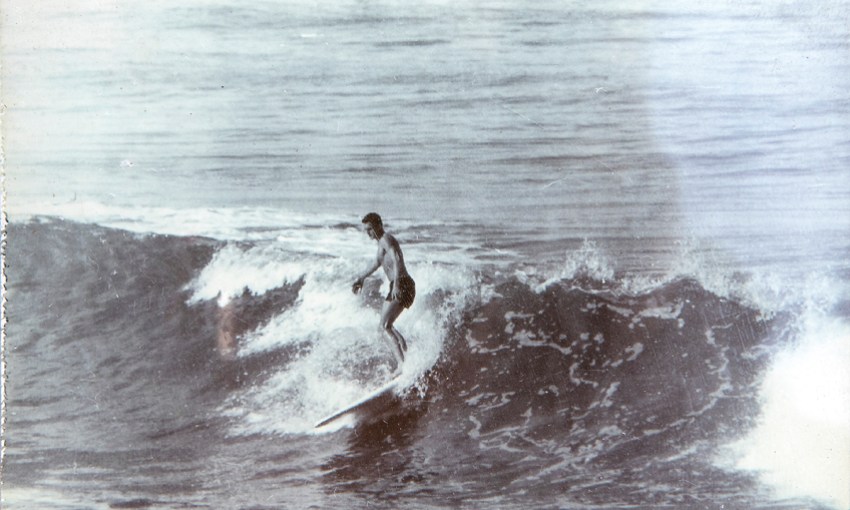
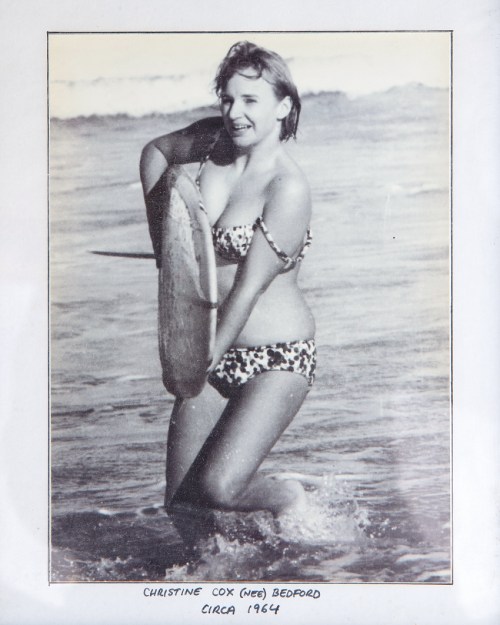
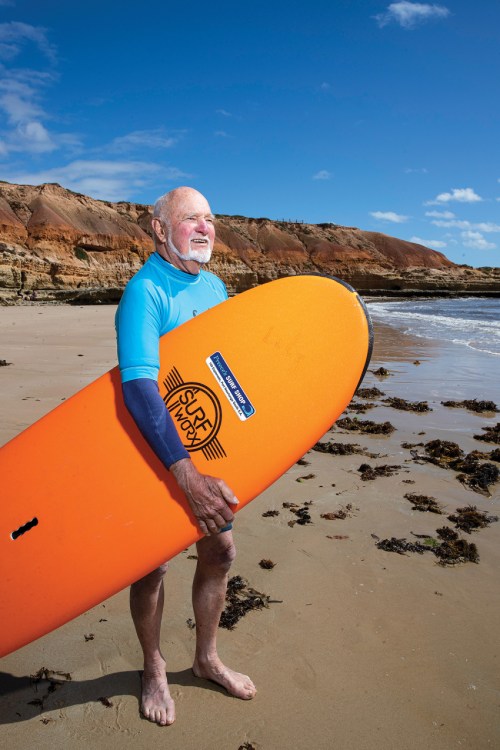
Peter and Christine were eventually married in 1966 and Peter got work at Chrysler while Christine worked at her father’s surf shop.
Christine’s brother, Rodney, also worked in the family business, and went on to make surfboards under various brands, including Cutloose.
Surfing remained at the centre of Peter and Christine’s lives, including when they started their family. They had four children aged under four, Teresa, Serena, Katrina and Martin, which “kept Christine from surfing for a while”, Peter says.
As well as juggling her family, Christine was also involved in setting up the official surfing association in South Australia.
“Through her work at the shop Christine was in touch with other board-builders around Australia and she found out they had associations,” Peter says. “She’d already started our own club when she first started working for her dad, the Southern Cross Surf Board Riders. There were other clubs formed around the same time in SA in the early 1960s, so Christine thought all these clubs should get together as an organisation.
“We made a lot of friendships around Australia and in the early days we’d go to a different state and location to perform in the Australian titles.
“Once the children were of competing age, we were off to these competitions, all six of us.”
These days, at 78, Peter continues to surf and competes with the Classic Lines club, although he admits COVID and the colder weather has slowed him down a bit.
Sadly, 11 years ago, Peter lost his beloved Christine to cancer.
He says he misses her enormously, especially when he is out on the waves surfing with his nine grandchildren aged from nine to 22 years.
As he did with his children, Peter has cherished helping his grandchildren develop their surfing talents and all of them are heavily involved in surfing and surf life-saving across South Australia, Byron Bay and Margaret River.
“I used to be behind them in the water encouraging them, saying ‘move forward’, then ‘come back’, ‘get ready to turn’,” Peter says.
“Now they say, ‘come on Grandpa, get out of the way, go faster’. I love surfing with them. It is such a big part of our family scene.”
Peter’s daughter Serena lives in Byron Bay where she runs a surf school for older women, taking groups on surfing tours to the Maldives and Bali.
“So, she’s a lot like her mum,” Peter says. “All our kids are.”
Christine continued to surf all through her life, particularly when Peter retired 23 years ago and the couple moved to their beach house at Middleton.
While he admits he’s puffing a lot more these days, Peter says he’ll continue to surf as long as he can.
“I just love it because you are depending on yourself a lot and you are up against nature,” he says. “I love the speed as well.
“You don’t feel as fit as you did and you miss friends who have passed away, but the best thing is not to let it play on your mind but you can’t help thinking about it.
“Most of us surfers feel we are a bit invincible.”



